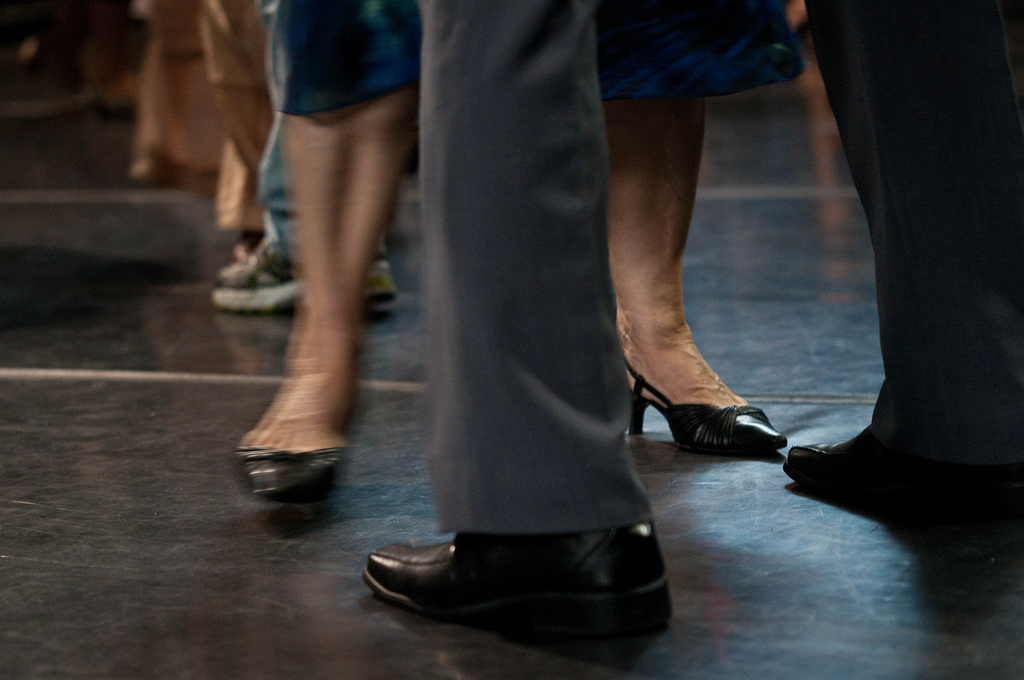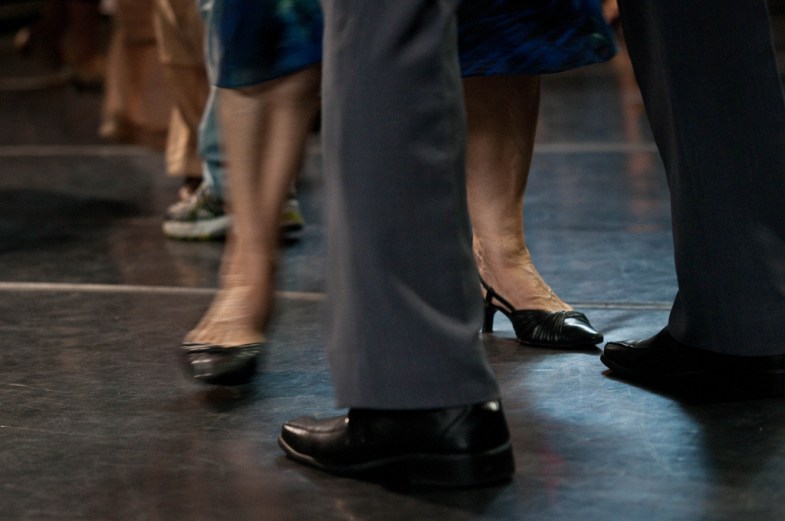How Dancing Cured My Anxiety
“You learn that your personality has a certain shape, with definite, inflexible bounds -- bounds you find out about because you keep bonking into them headfirst when you try to change.” — Attribution unknown.


For me, the activity to repeatedly show me that, yes, my personality does indeed have a certain shape, with rigid – very rigid — boundaries is dancing. Whenever I confront these boundaries or try to lean just beyond them, my brain gives me a crippling rush of anxiety, like a curious little dog in an electric shock collar – stray too far outside of your perimeter and ZAP!
Lesson learned.
It’s called the comfort zone for a reason.
For most of my life, I’ve desperately tried to avoid the spotlight; doing just about everything in my power to remain unseen, either by removing myself from a situation altogether, pretending to look busy, or finding a way to numb myself. Anything than to render myself vulnerable to the scrutiny of others, because that would be the most terrifying outcome of all.
Of the few times I thought to be brave and push the boundaries of my comfort zone, to lean into my discomfort and paralyzing fear of dancing, I went to bustling, bright night clubs. I would drink myself into a stupor until the whole scene turned into one blurry music video revolving around me. I felt like John Cusack in Being John Malkovich. Just an observer sitting in the passenger seat, looking through the windshield at all the inebriated bodies moving to the thumpy beat of edm music. I couldn’t even attempt to dance because the anxiety was that strong, dictating my actions. Or lack thereof.
Rather than tear it up at weddings, I hit the open bar and sulked or smoked. I hid in bathrooms. I dreaded going to proms, and I feel weird moving my body at concerts.
Even as a little kid, dancing was my Achilles heel.
I was in middle school, and we had school dances every two months or so — ‘socials’ we called them. The only reason I went to these socials was to hang out with my friends and eat junk food. This was the time when all my friends were stepping up and giving dancing a try. They would just fucking do it. No stress. No paralyzing anxiety. Just fun.
The courage!
After the last of my friends gave in and joined the ocean of dancing kids, the “shit, what do I do now” feeling washed over me. I started fidgeting and shifting my feet, as I do in such situations. With my back to the wall, I scanned the perimeter, hoping to catch another lost soul; another fearful, non-dancer. Nope. It was just me. Just me and my entire class dancing in the dark to the song “Butterfly” by Crazy Town blaring on the sound system. Remember that one?
I was alone.
Afraid.
Very fucking anxious.
“Californication” came on next — egads, a slow song! Right as the chorus started, the cute girl in the class started walking over to me. She emerged from the fluid mass of bodies like some sort of sexy Moses parting the Dead Sea. Her approach felt like an eternity. I knew what was going to happen next, so I fled the scene. She caught up with me outside and asked if I wanted to dance with her. “No thanks, I don’t know how to dance” I mumbled, failing to make eye contact.
She insisted.
I resisted.
And that was it.
So debilitating was my fear of being vulnerable that I couldn’t even dance with this girl — a girl who asked me to dance no less.
Ten years later, and after much introspection and having thrown in the towel from those hazy nightclub experiments, I decided that it was time to tackle this dancing thing once and for all. I had just moved into a new apartment and had that fresh new sense of adventure that comes with moving somewhere new. You almost feel like a new person, like you get a do-over; you get a fresh start to cultivate new habits and try new things. You get to be a new you, if you want to. For little while at least. I wanted to take full advantage of this do-over — this new me — so after much deliberation and postponement, I walked into a local dance studio to schedule a private lesson.
“A man with rhythm has the golden ticket,” she said.
“You know what? I think you’re right,” I replied, feeling proud of myself for taking action.
“The thing is, my ticket is more of a tinfoil type deal. Something you’d find in a CrackerJack box.”
“Or a Happy Meal”.
Michelle, my dance instructor, showed me the basic steps of swing, tango, and salsa, among others. It was just me and her, no one else around, no one to see me screw up. No one to see me really try. In rare, even unprecedented form, I allowed myself to be vulnerable, and it turned out to be a lot of fun.
True words from a straight, bookish white boy with a history of acute anxiety and two left feet.
I signed up for a few more lessons, and to my surprise, I found myself smiling deeply each session, laughing at myself, and slowly finding my rhythm.
There is Only Learning
In Jiu Jitsu they have a saying, “in practice there is no losing, there is only winning and learning. The only way to lose is to not practice.” When two people spar or roll on the mat, one person will win, that’s a given, but the other person? If he paid attention, he just learned a whole lot about his critical weaknesses. He can then use what he learned to get better — to grow. In this mindset, everything that happens is an opportunity for growth. Similarly, in zen buddhism they have a phrase for approaching the unfamiliar with an open mind — Beginner’s Mind. To approach something with Beginner’s Mind is to approach the experience with the innate selfless curiosity, enthusiasm, and playfulness of a child. Let’s call the combination of the two the ‘playful practice’ mindset. It wasn’t until I applied this mindset to learning how to dance that I actually started making progress in gaining competency, and ultimately, confidence. What I didn’t realize in my youth was that diving in headfirst and steadfast via bustling night clubs or school dances, is not the way to learn a new skill. Doing so just emphasized how uncoordinated I was and made me even less confident; pure losing, no learning. When I started taking tango lessons, I deliberately started off in a low risk scenario (one-on-one lessons) and gradually moved up to higher risk scenarios (tango classes), gaining competency along the way. The only way I was able to get better and become less anxious was to take a small step, leaning into my discomfort, get better, then take another step.
That’s the only way to build authentic confidence and competency. In anything.
Demonstrate Your Performance
“The way you penetrate your woman is the way you penetrate the world.” David Deida.
The first time I ever danced with my dance instructor, I’m sure I felt like playdough in her arms. Flimsy, unconfident, uncertain playdough — unassertive playdough! If you aren’t confident in what you’re doing, your partner will know instantly. There is an incredible amount of information exchanged when two people come together. As Carl Jung said, “the meeting of two personalities is like the contact of two chemical substances; if there is any reaction, both are transformed.” When a man wraps his arm around the small of a woman’s back, grabs her hand, and is about to take that first step, a barrage of information is communicated — information that will signal whether the man will be a confident, strong lead or a weak one.
For example: in tango, a strong lead leads with his upper body. His shoulders and torso are stern and strong, guiding the woman where to go, while his feet are nimble and quick, almost floating across the floor. If you lead with your feet, giving her the playdough upper body, she won’t be able to feel where you are trying to lead her. She’ll immediately know you have no idea what you’re doing — and that’s before you step on her foot.
To dance with a woman requires the confidence to demonstrate your assertiveness through your body language— to take action and signal to her that you can confidently lead her wherever you decide to go. In this way, dancing is deeply visceral, not verbal, ergo it cannot be faked. To build authentic confidence in dancing — or anything else — you must be able to demonstrate your performance. That is, to prove your competency to the world (and to yourself) by demonstrating that skill. The way I cured my anxiety was by starting at low risk scenarios and building up to high risk ones, and putting in the reps. That’s it.
As I built confidence in my skills, the anxiety plummeted and the fear dissolved.
Dare Greatly and Be Vulnerable
It wasn’t until I started taking those dance lessons that I realized how terrified of being vulnerable I was. Being vulnerable feels a lot like being naked. It feels like being naked when everyone else is fully clothed, or being naked onstage hoping for applause rather than laughter. In college I drank and smoked because I needed something to do with my hands. I hid in bathrooms at parties. I fidgeted and shuffled my feet at the dance in Kenya to look busy, and ran off rather than risk looking like a fool on the dance floor. I did these things to minimize my feelings of vulnerability, which in turn lead to anxiety and fear.
Vulnerability, as I learned, doesn’t have to feel like that though. It can also feel like being all in, like taking off a straightjacket, or, in most cases, it feels like taking the first step toward what you fear the most. For me though, it felt like I was ten years old again and learning how to ride a bike for the first time. Equal parts excitement and fear, I approached the unfamiliar with eagerness and a lack of preconception. When I started taking those dance lessons, I felt what it means to “lean into discomfort”, to take the first step towards quelling my fears.
I’m still an awful dancer. I still avoid dancing like the plague, but it’s not the insurmountable fear that it once was. It’s just a skill, and like any skill, it can be learned. I know because I’ve done it, and the strategy I used can be applied to any skill you can think of. Until I took those lessons, I was fertilizing my fear with indecision and postponement. Once I took action, gradually moving from low risk to high, and applied the ‘playful practice’ mindset, the anxiety began to dissolve and the confidence began to grow. ![]()

